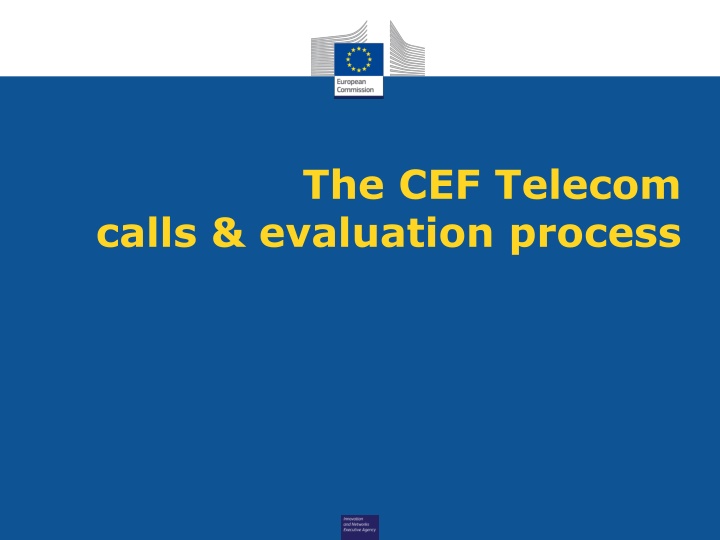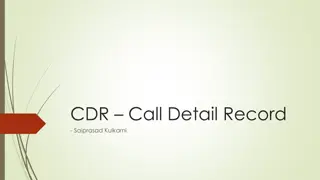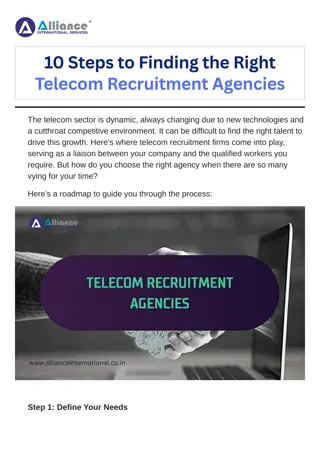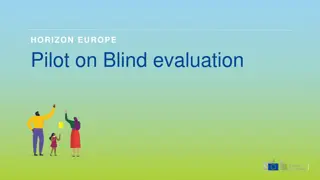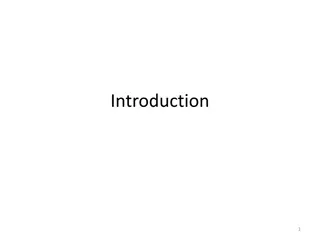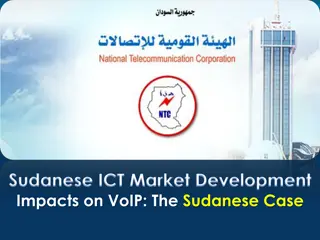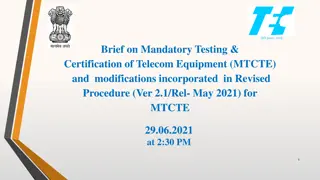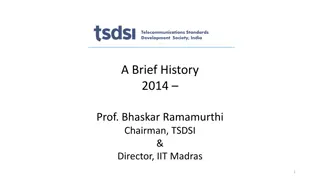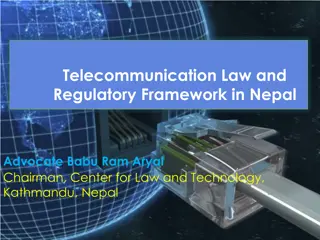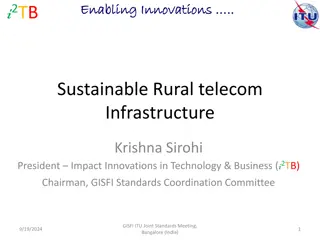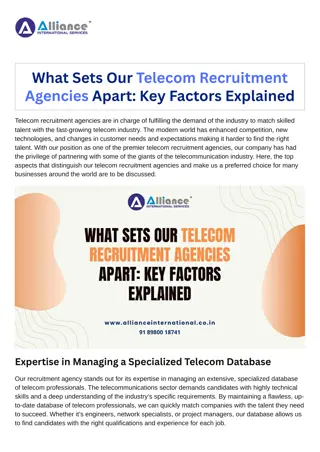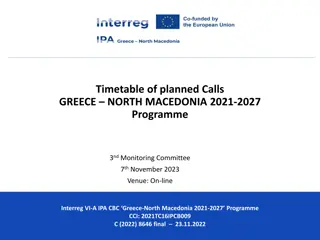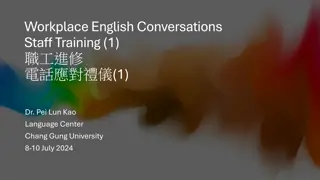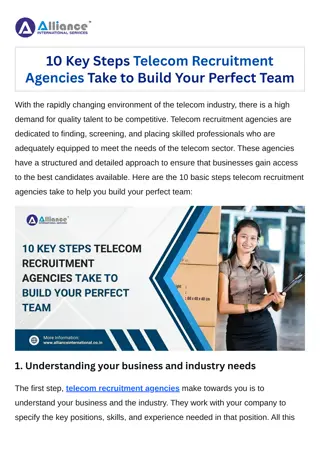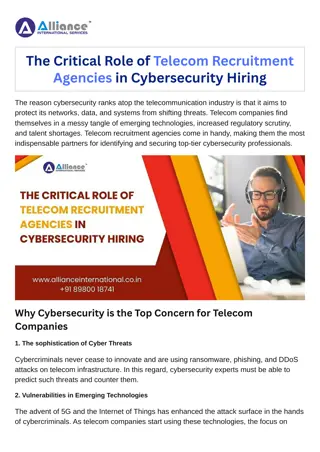CEF Telecom Calls & Evaluation Process
This content provides an overview of the CEF Telecom calls and evaluation process managed by INEA on behalf of the European Commission. It covers the legal basis, annual work programme, call information, call management details, and specifics of the 2016 CEF Telecom calls, including indicative budgets and deadlines. The process, guidelines, and objectives are explained, along with insights on eDelivery call scope for enhancing electronic delivery services across Europe.
Download Presentation

Please find below an Image/Link to download the presentation.
The content on the website is provided AS IS for your information and personal use only. It may not be sold, licensed, or shared on other websites without obtaining consent from the author.If you encounter any issues during the download, it is possible that the publisher has removed the file from their server.
You are allowed to download the files provided on this website for personal or commercial use, subject to the condition that they are used lawfully. All files are the property of their respective owners.
The content on the website is provided AS IS for your information and personal use only. It may not be sold, licensed, or shared on other websites without obtaining consent from the author.
E N D
Presentation Transcript
The CEF Telecom calls & evaluation process
Call management INEA manages the CEF programme & calls on behalf of the European Commission European Commission Innovation & Networks Executive Agency (INEA) Defines the policy Turns policy into action Defines strategy, objectives and priority areas/work programmes Organises calls for proposals Selects projects for co-financing Monitors the technical and financial implementation of projects Makes programme decisions Manages project lifecycle Evaluates the programme and the Agency's performance Ensures sound financial management 3
How do the calls work? Legal basis: CEF Regulation (Regulation No 1316/2013) Telecom Guidelines (Regulation No 283/2014) EU Financial Regulation and Rules of Application 2016 Annual Work Programme: Adopted 3 March (available on call page on INEA website) Outlines general CEF Telecom objectives and priorities for actions to be funded in a specific year Specific call text: Launched by INEA - together with application forms and various guidance documents Outlines all conditions of call 4
2016 CEF Telecom calls Call Indicative budget Launch date Deadline CEF-TC-2016-1 BRIS EESSI eProcurement CEF-TC-2016-2 eDelivery eID & eSignature eJustice Public Open Data CEF-TC-2016-3 Automated Translation Cybersecurity eInvoicing Europeana 3 million 24.5 million 4.5 million 3 March 2016 19 May 2016 0.5 million 4.5 million 2 million 3.5 million 12 May 2016 15 September 2016 6.5 million 12 million 7 million 2 million 13 September 2016 15 December 2016 5
2016-2 eDelivery call: scope Increase uptake and speed up the use of the eDelivery DSI amongst public and private entities Contribute to the compliance with the requirements set in the eIDAS Regulation to allow their use for the provisioning of electronic registered delivery services, including qualified ones Contribute to the compliance with the requirements set in relation to the deployment and/or operation of access points within other sectorial European Regulations (e.g. eInvoicing, transport, environment, energy, health, public e- procurement, justice). This will be done via the setting up of additional access points and service metadata publishers throughout Europe that link to the EU Core Service Platform 7
2016-2 eDelivery call: expected outcomes Helping access point and service metadata publishers to enable interoperability between European and national levels - regardless of the standards in use within each of the Member States. Ensuring convenient and secure cross-border transactions by allowing the implementation of interoperable solutions working within the trusted legal framework for electronic registered delivery services provided in the eIDAS Regulation 8
2016-2 eDelivery call: key conditions Who can apply? One or more Member States + EEA countries (Norway/Iceland) International organisations, joint undertakings, or public or private undertakings or bodies established in Member States - ith the agreement of the Member States/EEA countries concerned Consortium composition: minimum of 4 entities from one or more Member States Co-financing: 75% of the eligible costs of the action Indicative duration: 24 months 9
2016-2 eID & eSignature call: scope Integration of the eID and/or eSignature DSI in an existing e-service/system /online platform operating cross border to enable private and public sector entities (including local administrations) to accept issued eIDs and eSignatures from any Member State eID: Primary focus on a few selected private sector areas presenting potential high volume cross-border transactions (i.e banking, electronic/Internet payment services, other financial services, insurance and aviation) eSignature: Support for public sector entities involved in the establishment and operation of the points of single contact under the Services Directive, as well as by public sector bodies in view to comply with the requirements set in the eIDAS Regulation Integration of the tools provided by the eSignature DSI by public sector bodies in order to facilitate the cross-border completion of electronic procedures by companies applying for administrative decisions with public administrations of other Member States. Priority to the public and private sector bodies which manage the points of single contact under the Services Directive 11
2016-2 eID & eSignature call: expected outcomes Increasing the widespread uptake and use of eID by the private sector - which are potentially the largest users and contributors to the Digital Single Market Improving the cross-border acceptance of eSignatures by public sector bodies, promoting business mobility and increasing the interoperability of eSignatures 12
2016-2 eID & eSignature call: key conditions Who can apply? One or more Member States + EEA countries (Norway/Iceland) International organisations, joint undertakings, or public or private undertakings or bodies established in Member States - ith the agreement of the Member States/EEA countries concerned Consortium composition: minimum of 4 entities from one or more Member States Co-financing: 75% of the eligible costs of the action Indicative duration: 12 months 13
2016-2 European e-Justice Portal call: scope Encourage the interconnectivity (development, deployment, testing and generic services in EU Member States which will allow the modules of the e-Justice Portal to serve a greater audience and thus better fulfil their public function. Interconnection of Insolvency Registers Find a lawyer/Find a notary European Case Law Identifier (ECLI) Access to e-CODEX European Court Database 15
2016-2 European e-Justice Portal call: expected outcomes Interconnection of Insolvency Registers: Improving the provision of relevant and timely information to creditors and courts involved and preventing the opening of parallel insolvency proceedings. Allowing certain Member States to expediently comply with the requirements of the EU Regulation on insolvency proceeding Interconnecting Member State insolvency registers via the European e-Justice Portal Find a lawyer/Find a notary: Facilitating access to justice in particular in a cross-border context Extending and completing coverage in terms of Member State participation Providing a comprehensive EU-wide search engine for finding members of these two legal professions across Europe European Case Law Identifier (ECLI): Implementing technical solutions allowing access to national case law at the national and European levels in compliance with the ECLI standard 16
2016-2 European e-Justice Portal call: expected outcomes Access to e-CODEX: Enlarging the Member State coverage where electronic use of the European Order for Payment and the European Small Claims cross-border legal instruments is possible, and thus enabling courts to receive electronic submissions of claims from citizens, business and legal practitioners across the EU European Court Database: Enabling a smoother and enhanced process of Member State data provision to the Database, resulting in more up-to-date and accurate information 17
2016-2 European e-Justice Portal call: key conditions Who can apply? One or more Member States + EEA countries (Norway/Iceland) International organisations, joint undertakings, or public or private undertakings or bodies established in Member States - ith the agreement of the Member States/EEA countries concerned Consortium composition: no specific requirements, but please see section 3 of the call text for more info about who can apply for which generic service Co-financing: 75% of the eligible costs of the action Maximum duration: 24 months 18
2016-2 Public Open Data call: scope Continue the support to the generation, aggregation and cross-border/cross domain harmonisation of open datasets at all levels of government, including cities, integrating the support provided by the CEF Telecom 2015 work programme Foster the availability of harmonised and detailed datasets content description for their full and informed use 20
2016-2 Public Open Data call: expected outcomes Boost the development of information products and services based on the re- use and combination of open public data across the EU and contribute in particular to: Improve the availability of harmonised content at the EU level Increase the transparency and availability of innovative services for citizens; increase the overall efficiency of public services and administrations. Assist the innovation ecosystems of startups/development of apps, which can strongly benefit from open data and platforms Promote the availability of good quality, reliable and interoperable datasets and enabling data portals infrastructure to allow the full potential of Open Data to be exploited Support the functioning of the European Data Portal as the one-stop-shop for Open Data across the EU Support the priorities of Digital Single Market, boosting competitiveness through cross-border interoperability and standardisation and facilitating easy interaction with citizens 21
2016-2 Public Open Data call: key conditions Who can apply? One or more Member States + EEA countries (Norway/Iceland) International organisations, joint undertakings, or public or private undertakings or bodies established in Member States - ith the agreement of the Member States/EEA countries concerned Consortium composition: minimum of 2 public administrations from two different Member States Co-financing: 50% of the eligible costs of the action Indicative duration: 24 months 22
Principles for the evaluation and selection process Basis: eligibility, selection and award criteria of the work programme and the call for proposals Equal treatment: all proposals evaluated against the same criteria; no preferential treatment to any applicant Transparency: adequate feedback to applicants on the outcomes of the evaluation 25
Call publication & application support Call published in Official Journal and announced on specific call page on INEA website Call texts, Guide for Applicants, application forms prepared by INEA and available on call page at publication Helpdesk operational as of call publication: FAQs now available on call page Virtual Info Day: 3 June 2016 26
Admissibility/Eligibility Committee (INEA) Checks compliance with admissibility conditions, eligibility and selection criteria Proposal submitted on time, complete, signed by the applicant Applicants demonstrate the support of the concerned Member State and are not in an exclusion situation Proposal addresses the DSI in question and has the right consortium composition Applicant has the financial and technical capacity to carry out the action Proposal complies with relevant EU legislation (public procurement) 27
Technical Evaluation: overview Independent external experts provide technical assessment on the basis of the information submitted in a proposal in a two-step process: 1. Individual reading of proposals (remote or onsite at INEA) 2. Consensus meeting for each proposal (onsite at INEA) Experts and an INEA moderator meet to agree on comments and scores for the award criteria The proposal must have at least 3 points for each criterion to be considered for funding. Overall threshold = 10 points (applying to the sum of the three individual scores) 28
Award criteria Quality & efficiency of implementation Relevance Impact & sustainability Alignment to DSI implementation objectives & activities (WP) Maturity Coherence/effectivess with work plan Quality of consortium/consortium members Support from national authorities/industry/NGOs Attention to security/privacy/ inclusiveness/accessibility Quality of the approach to facilitate wider deployment/take-up of the proposed actions Alignment to EU/national policies, strategies and activities Capability of long-term sustainability without EU funding 29
Internal Evaluation Done by the Commission Does not re-evaluate the proposals but uses the experts recommendations to prepare a ranking list (and any reserve lists) Identifies potential double funding and/or any other issues that would influence the selection of proposals Discusses where appropriate any potential transfer of budget from one call to another 30
Selection Decision Member States approve the Selection Decision in the CEF Coordination Committee European Parliament is informed on the list of selected projects Selection Decision is adopted formally by the Commission Publicity actions (i.e. press release) carried out after adoption of Selection Decision 31
Grant agreement Once Decision is adopted, successful applicants are invited to by INEA to prepare the individual grant agreement Grant agreement is signed between the beneficiaries (applicants) and INEA and covers the technical, legal and financial aspects of the proposal based on evaluation results Model grant agreement is published on INEA website on the call page Project management carried out by INEA 32
How to apply 33
Before you get started Read through all of the call documents on the call webpage, especially: Work Programme (Annex) Call text Take special note of the Priorities (section 3) and Results (section 4) which provide specific information on what is expected in the proposals Carefully read the Award Criteria (section 10) which explain on what the proposal will be evaluated Guide for Applicants 34
Proposal submission Fully electronic proposal submission done via TENtec system used to manage the CEF projects during their entire lifecycle and which enables the electronic submission of proposals under the CEF calls All application forms and access to TENtec eSubmission module available via call page on INEA website 35
Application form Part B Part A Administrative information Main characteristics of the proposal Application Form Part D Part C Technical and financial information Information on compliance with EU law 36
Application form A Essential information on the applicants and on the proposal (summary of the action, timing, activities and milestones, budget and requested funding) Must be completed in the TENtec eSubmission module, Word version provided for reference on call webpage Includes forms that require signature of the applicants (A2.2) and Member State validation (A2.3) Be complete, informative and precise: the descriptions of the proposed Action and activities will also be used for the grant agreement 37
Application form B Further administrative information on applicants and info use to demonstrate compliance with the financial & operational capacity Legal entity form, financial identification form, additional supporting documents Member States, third countries, public entities established in the EU and international organisations DO NOT need to demonstrate financial and operational capacity Annexes B-I, B-II, B-III, B-IV to be completed, signed, stamped (B-III), and uploaded if applicable 38
Application form B Financial and operational capacity check Required by Financial Regulation Financial capacity check Financial analysis based on a set of ratios, carried out as same time as evaluation applicants to supply information based on amount of grant requested Operational capacity check Proof of technical and operational capacity of applicant to complete the proposed Action Complements information from application form D2.3 Proof: activity report, CVs, reports on similar projects, etc 39
Application form C Information on compliance with EU law on public procurement Information on other sources of EU financing that may be received by the proposal (cannot receive grants from two EU funding sources) 40
Application form D Detailed, technical information describing the proposed Action and its activities i.e. the heart of the proposal Order of the questions reflects the award criteria address each point and subpoint in your application to ensure that your proposal contains all of the relevant information on which it will be assessed. Don't forget the Gantt chart/other annexes 41
Tips to improve your proposal: content Provide ALL relevant information on the application forms - don t rely on additional supporting documents Be consistent in describing the objective, activities, duration and budget in your responses to different questions and parts of the application form Present a clear time table and planning overview, explain possible risks and delays and provide evidence that these are being addressed Show evidence that the proposed Action supports the objectives/aims of the call + addresses the award criteria Justify why the financial support is needed Use simple, clear language! Responses need to be clear, well-structured, substantiated and concise -> experts have limited time to read and assess the proposals 42
Tips to improve your proposal: process Start early (especially for Member State endorsement and multi-applicant proposals) Save your proposal often in the system Avoid upoading all supporting documents and information at the last minute Visit your call webpage regularly to check for updates, sign up for our Twitter feed for notifications 43
Guidance and help available Call webpage: Work programme Call texts Other key legal and technical documents Member State contact points Useful links Guide for Applicants Presentations and video footage from 3 June Info Day Proposal checklist 44
Guidance and help available Helpdesk: INEA-CEF-Telecom-calls@ec.europa.eu FAQs (general and DSI specific) and FAQ notification service Where relevant for all applicants: answers published in FAQs (no individual responses!) Where too specific to a proposal and would provide a comparative advantage: not answered FAQ deadline (2016-2): Thursday 1 September - last FAQ update online Thursday 8 September Individual responses will be provided until the deadline on technical questions related to TENtec eSubmission module 45
Submitting the application Follow the steps as detailed in the Guide for Applicants Part A must be filled in TENtec eSubmission module Parts B, C and D can be completed in native applications and uploaded as attachments Upload all forms requiring signatures (e.g. A2.2, A2.3, Annexes B-I, B-II, B-III) make them clearly identifiable by their title Don't forget any supporting documents Keep your originals they may be requested later Submit in TENtec before the deadline: Thursday, 15 September 2016, 17:00.00 (Brussels time) 46
Next steps (indicative) September-December 2016: evaluation January-February 2017: legislative process and adoption of the Selection Decision Starting from February 2017: announcement of results and negotiation of individual grant agreements for the successful proposals Best of luck! 47
For more information inea-cef-telecom-calls@ec.europa.eu inea@ec.europa.eu http://ec.europa.eu/inea https://ec.europa.eu/inea/en/connecting- europe-facility/cef-telecom/apply-funding/2016- cef-telecom-calls-proposals @inea_eu
